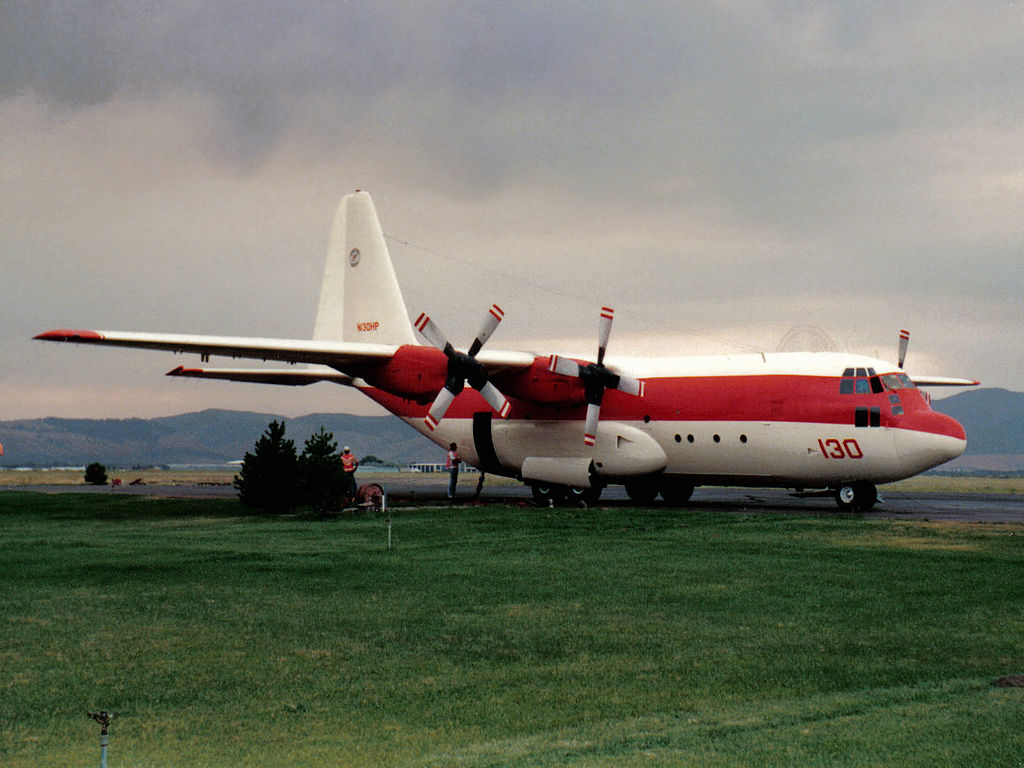In 2002, a C-130, call sign Tanker 130 owned by Hawkins & Powers Aviation of Greybull, Wyoming, and operated under contract to the United States Forest Service, had its wings fall off mid-flight as it was fighting northern Californian wildfires.
In 2002, a C-130, call sign Tanker 130 owned by Hawkins & Powers Aviation of Greybull, Wyoming, and operated under contract to the United States Forest Service (USFS), had its wings fall off mid-flight as it was fighting northern Californian wildfires. It rolled, inverted, and crashed into the forest below, killing all three crewmen (pilot Steve Wass, co-pilot Craig Labare, and flight engineer Michael Davis) aboard.
The NTSB investigated the crash and determined that the accident was caused by a structural failure that occurred at the wing-to-fuselage attach point, with the right-wing failing just before the left. The investigation disclosed “evidence of fatigue cracks in the right wing’s lower surface skin panel, with origins beneath the forward doubler.
Cy Birr, a Retired USAF pilot after 24 years flying the C-130, adds some interesting details about the accident on Quora.
‘The 2002 Walker, California crash of C-130A, N130HP, Tanker 130 has often been attributed to structural failure (the simplest ‘correct’ answer), a design flaw (partially correct), and human factors (incorrect when referring to this crew). Like most accidents simple answers only are sufficient for the simple,’ Birr says.
‘This C-130’s history is an important part of the story. Specifically, it was one of the original 1957 production models and among only a few still considered airworthy in 2002. Tail 56–0538, the original USAF designation, had seen service in Europe, Southeast Asia, and the Americas. Like all USAF aircraft, it possessed a detailed flight and maintenance history in the archive that accompanied the aircraft throughout its service life. Except… in the late 1960s the aircraft’s library showed a break in record keeping of over four years. 56–0538 had been released from the USAF to a program that “partnered” with “industry”. The particular company for this partnering, Southern Air Transport. Southern Air Transport was a front company for the CIA.
‘This aircraft spent four years without any documented details on its maintenance history. There is nothing available as to the use, environment, and employment of the airframe. It is unknown if the aircraft experienced overloading, over-g, or any other potential airframe compromising damage or use.’
He continues:
‘Once returned to the USAF the plane was placed in the USAFR inventories and used by a number of squadrons. Maintenance was performed and documented but this was during the “hollow force” era and attention to detail was not as much of a priority for understaffed and underfunded units. Deferments of depot-level activity and other heavy work occurred. Add to this the arrival of the C-130H models, the presence of C-130E models, and the attention to the C-130A simply wasn’t there. This was most obvious in the USAF’s decision to not replace the center wing box of the A-models when Lockheed advised it as a recommended upgrade (the late 70s, early 80s). C-130E and H1 were modded but not the A-models. Most of the A-models were turned over to the boneyard by 1988.

‘56–0538 was sold as surplus to other USG entities in 1986. Renamed N130HP it was taken on by the General Service Administration and released to the Department of the Interior after modding for fire suppression. It was successfully used for years. Crews performed many, many water drops using established procedures without complaint.
‘That all changed on 17 June 2002. Tanker 130 had completed the water release and was pulling up when the wing-to-fuselage connection (center wing box) failed. The NTSB determined structural fatigue from decades of use caused a fatal propagation of cracks associated with rivet holes. These cracks compromised the stringers (think ribs of a reinforced box) and resulted in catastrophic failure at a g-load well within designed parameters. The crew was found to have had no part of the blame.’
Birr concludes:
‘The reason I brought up the CIA period of service is another C-130A associated with Southern Air Transport showed higher degrees of compromise than the C-130A that had remained in the military. We will never know if improper use and loading by Southern Air Transport contributed to the failure.
‘Like most tragedies, some good came out of it. The DoD implemented a fleet-wide examination of C-130 wing boxes of all types. The inspections found multiple problems. Some similar, some only by coincidence. But the result was significant programmed maintenance changes and use restrictions until changes were accomplished.’
On Jul. 18, 2002, another aircraft owned by Hawkins & Powers Aviation and operated under contract to the (USFS), a Consolidated PB4Y-2 Privateer crashed near Estes Park, Colorado. Both crewmen were killed in the crash.
These crashes prompted a review of the maintenance and use of the entire U.S. large air tanker fleet.
The crashes occurred in one of the worst fire seasons in the last half-century, one in which 73,000 fires burned 7.2 million acres (29,000 km2) of land.
The following horrific video features the 2002 Tanker 130 crash.
Photo by KOLO-TV Reno via The Sacramento Bee and Armen Woosley from La Grande, USA via Wikipedia

